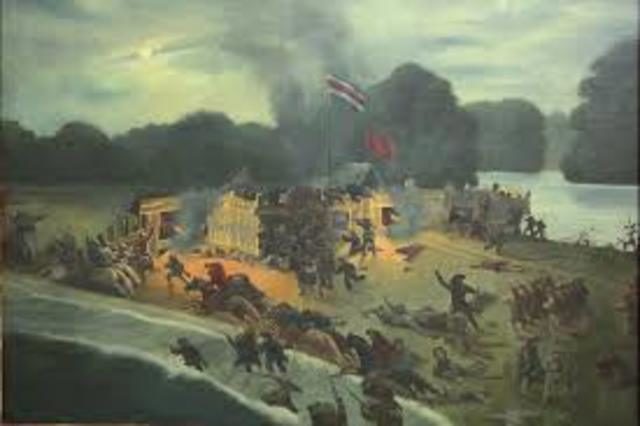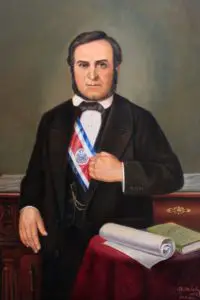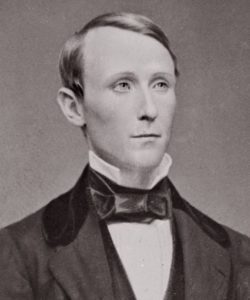The battle of Sardinal was an armed conflict that took place on April 10th, 1856, in the town of Sardinal, in Sarapiquí, Costa Rica. It was the 2nd battle of the National Campaign of 1856-1857 that confronted the Costa Rican army against the filibusters of William Walker, after the Battle of Santa Rosa, on March 20th, 1856, in Guanacaste.

In fact, it was the last battle of the National Campaign disputed in Costa Rican territory. From there, the rest of the war would have the Nicaraguan territory as its scenario. For the Costa Rican army, the combat of Sardinal allowed maintaining the strategic defensive position on the national territory, by blocking the fluvial access of the filibusters towards the interior of the country through the Sarapiquí River. The battle was generated when the Costa Rican troops decided to move towards Nicaragua, but these had to go through Alajuela to Sarapiquí.
Before this happened, the group of filibusters who were in La Trinidad had heard that the Costa Ricans were sailing on the Sarapiquí River. Then, the enemy took a course towards the same place, so both armies met and faced each other on the Sardinal River -it is from where the Sarapiquí River drains. So the filibusters arrived at the place to face the Costa Ricans. When both sides met, they faced each other for more than an hour, and as the minutes passed, neither of the 2 sides had won. Thus, the filibusters who were commanded by William Walker withdrew from the place after seeing frustrated their opportunity to conquer Costa Rican territory. They headed towards La Trinidad, while the Costa Ricans headed towards El Muelle. The filibusters lost 4 men on land and many in the water, in addition to the sinking of a boat.
On the other hand, the Costa Rican group had the loss of 1 man, 2 missing and, in addition, some got wounded. The filibusters were a group of North Americans who were trying to impose themselves on Central America by the use of violence. These men had an ideology which tried to extend the dominion of the United States to the southern part of its borders. Their plan was to convert the countries that they annexed or conquered, into members of the slaving states located south of their continental territory.
The Costa Rican army was not as it was believed during a certain time; they were just a group of humble peasants who went to fight with sticks. On the contrary, those filibusters were very well-prepared, because they had modern weapons, uniforms, and good ammunition. The president of Costa Rica not only foresaw the danger but put himself at the head of the national army to defend against the foreign invaders.
The war began in March 1856 and ended in May 1857. The 1st battle took place on March 20th, 1856, at the hacienda of Santa Rosa, which the Costa Ricans won. Later, the army was ordered to pursue the filibusters who were heading north. This 2nd battle that took place in Sardinal, a district that belongs to the canton of Sarapiqui, in Heredia. It happened when Juan Rafael Mora Porras, through a smart strategic move, sends part of his men to protect the entrance of the Sarapiquí River, while others went to Rivas. This route that the Ticos soldiers used to get to Sarapiqui was destined for trade, although it was little used because of its difficult access.
Then, his soldiers arrived at Heredia and crossed Vara Blanca until they reach Sarapiquí. That is where they met the filibusters and the battle took place. If the Costa Rican army had lost, it would have changed the whole outcome of the war, because the filibusters would have continued towards the central valley and in, a pretty short time, they would have conquered Alajuela and Heredia, and even could have managed to seize San José, which was in the north. That is why this point was so crucial. And our gratitude is owed to Juan Rafael Mora Porras.

Paradoxically, this battle has been one of the most forgotten points of the National Campaign and, thus, reducing the merit of Mora Porras. According to some versions of the story, especially that of Lieutenant Orozco (1856), an eyewitness of this battle, and those of the historians Rodríguez (1955) and Obregón (1956), the battle begins at 8 o’clock on the morning of April 10th, 1856, in the Sardinal stream, in Sarapiqui.
It was led by the Florentine General Alfaro, who was wounded in the arm, and soon replaced by Lieutenant Orozco. The filibusters arrived in approximately 4 or 6 vessels, with around 100 men; and the Costa Rican army, according to Orozco and Obregón, also totaled around 100. The battle lasted approximately one hour and the losses of the Tico soldiers were few. This was the 2nd triumph of the Tico army, so Rodriguez indicates that our country showed that it was prepared to defend itself, and Obregón highlights the braveness with which the Costa Ricans defended their sovereign rights.

Yet, ironically, according to Walker, in his book “War in Nicaragua” (1860), the filibusters vigorously attacked the Costa Ricans, leaving 20 dead and defeated them, consequently, making them flee to San José. This is an untrue, fallacious version, since it totally falsifies the facts, with Walker lying in his own favor.
It is very important to point out that, currently, the Battle of Sarapiquí is being given the importance it deserves, along with the merits to Juan Mora Porras. In his honor, one of the public auditoriums in that municipality has been named “Auditorio Juan Rafael Mora Porras”. Also, April 10th is considered a holiday and declared the 2nd Day of the Sarapiquí Canton” as a way of retaking the historical memory to honor the bravery shown by the Costa Rican army in the battle of Sardinal.
In this regard, we urge our citizens to study the historical role of Juan Rafael Mora Porras as a national hero, since his accomplishments as president were essential for the formation of our national identity.

